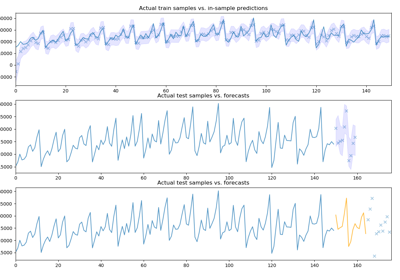pmdarima.preprocessing.FourierFeaturizer
- class pmdarima.preprocessing.FourierFeaturizer(m, k=None, prefix=None)[source][source]
Fourier terms for modeling seasonality
This transformer creates an exogenous matrix containing terms from a Fourier series, up to order
k. It is based onR::forecast code[1]. In practice, it permits us to fit a seasonal time series without seasonal order (i.e.,seasonal=False) by supplying decomposed seasonal Fourier terms as an exogenous array.The advantages of this technique, per Hyndman [2]:
It allows any length seasonality
The seasonal pattern is smooth for small values of K (but more wiggly seasonality can be handled by increasing K)
The short-term dynamics are easily handled with a simple ARMA error
The disadvantage is that the seasonal periodicity of the time series is assumed to be fixed.
Functionally, this is a featurizer. This means that exogenous features are derived from
y, as opposed to transforming an existing exog array. It also behaves slightly differently in thetransform()stage than most other exogenous transformers in thatexogis not a required arg, and it takes**kwargs. See thetransform()docstr for more info.- Parameters:
- mint
The seasonal periodicity of the endogenous vector, y.
- kint, optional (default=None)
The number of sine and cosine terms (each) to include. I.e., if
kis 2, 4 new features will be generated.kmust not exceedm/2, which is the default value if not set. The value ofkcan be selected by minimizing the AIC.- prefixstr or None, optional (default=None)
The feature prefix
Notes
Helpful for long seasonal periods (large
m) whereseasonal=Trueseems to take a very long time to fit a model.
References
Examples
>>> import pandas as pd >>> from pmdarima.preprocessing import FourierFeaturizer >>> from pmdarima.datasets import load_wineind >>> y = load_wineind() >>> trans = FourierFeaturizer(12, 4) >>> y_prime, X = trans.fit_transform(y) >>> X.head() FOURIER_S12-0 FOURIER_C12-0 ... FOURIER_S12-3 FOURIER_C12-3 0 0.500000 8.660254e-01 ... 8.660254e-01 -0.5 1 0.866025 5.000000e-01 ... -8.660255e-01 -0.5 2 1.000000 -4.371139e-08 ... 1.748456e-07 1.0 3 0.866025 -5.000001e-01 ... 8.660253e-01 -0.5 4 0.500000 -8.660254e-01 ... -8.660255e-01 -0.5
Methods
fit(y[, X])Fit the transformer
fit_transform(y[, X])Fit and transform the arrays
get_metadata_routing()Get metadata routing of this object.
get_params([deep])Get parameters for this estimator.
set_output(*[, transform])Set output container.
set_params(**params)Set the parameters of this estimator.
set_transform_request(*[, n_periods])Configure whether metadata should be requested to be passed to the
transformmethod.transform(y[, X, n_periods])Create Fourier term features
update_and_transform(y[, X])Update the params and return the transformed arrays
